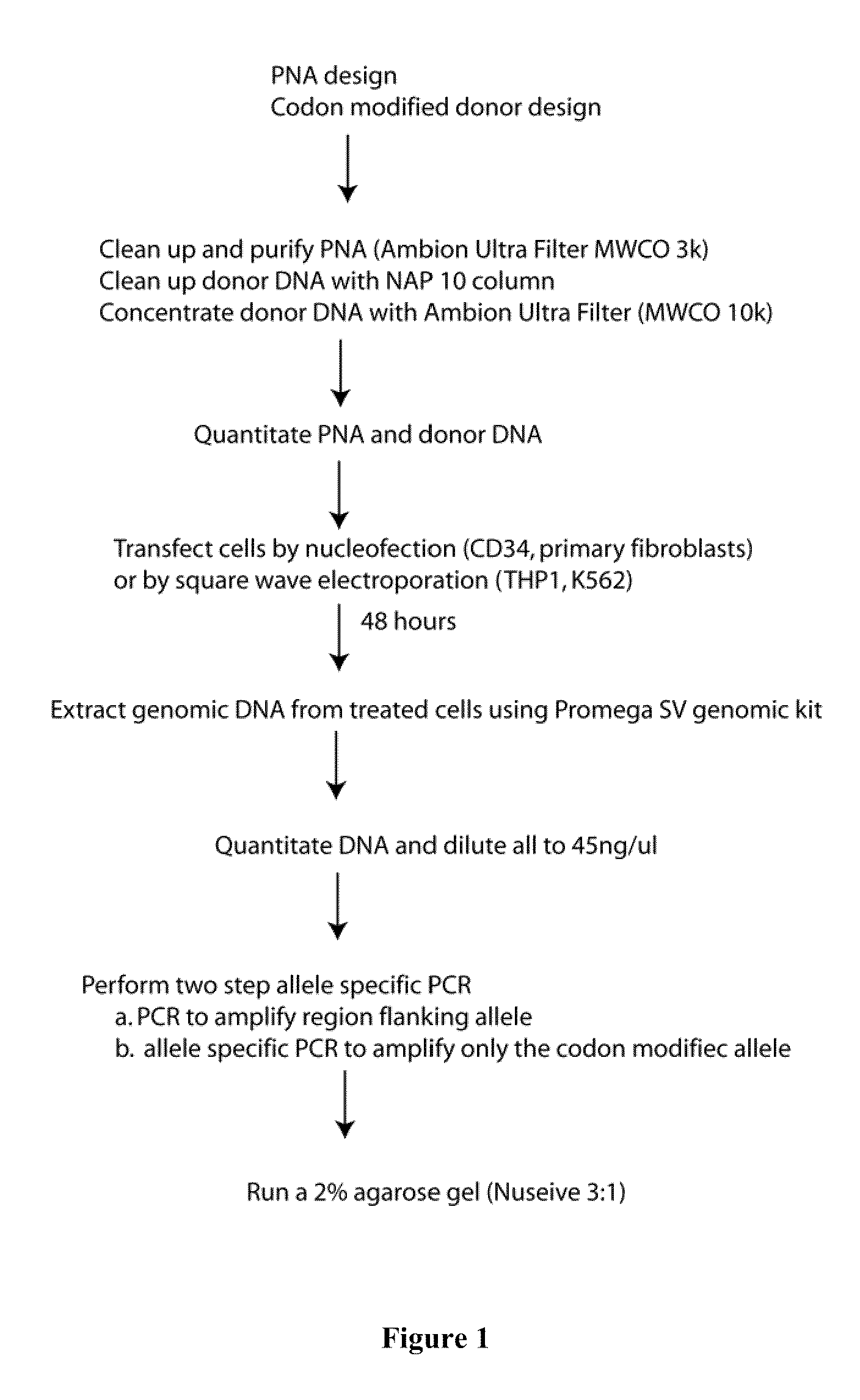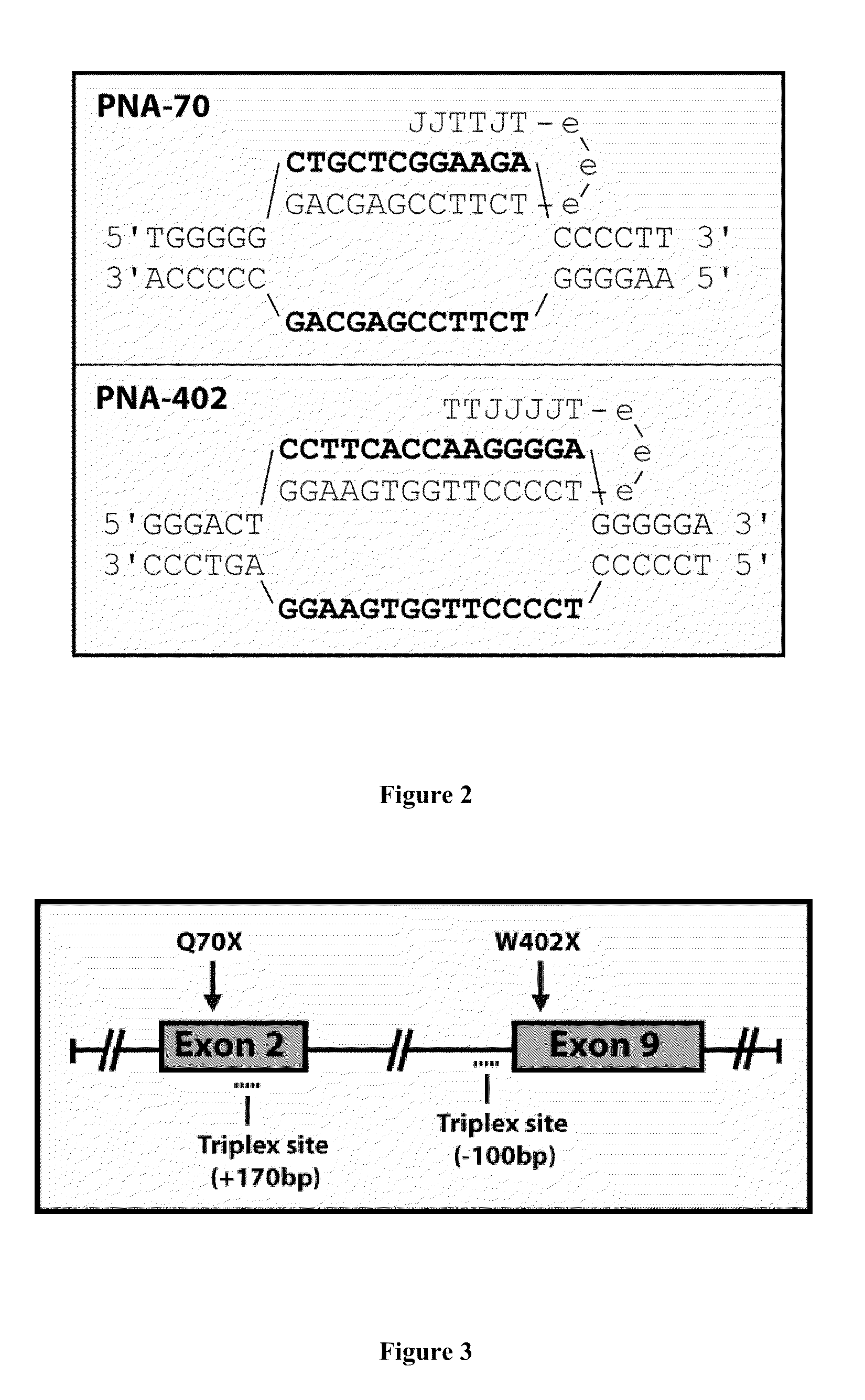Compositions and methods for treatment of lysosomal storage disorders
a technology of lysosomal storage and composition, applied in the direction of drug composition, peptide/protein ingredient, metabolic disorder, etc., can solve the problems of buildup or “storage” of these materials within the cell, and achieve the effect of restoring enzyme function
- Summary
- Abstract
- Description
- Claims
- Application Information
AI Technical Summary
Benefits of technology
Problems solved by technology
Method used
Image
Examples
example 1
Triplex Formation at Two IDUA Gene Target
[0155]Materials and Methods
[0156]Design of Triplex-Forming Molecules
[0157]The generic sequences for IDUA402tc715 and IDUA7Otc612 are depicted schematically in FIG. 2. IDUA402tc715 is a tail clamp peptide nucleic acid (tcPNA) with the sequence Lys-Lys-Lys-TTJJJJT-OOO-TCCCCTTGGTGAAGG-Lys-Lys-Lys (SEQ ID NO: 5). This triplex-forming molecule contains a 7 base pair Hoogsteen binding portion and 15 base pair Watson-Crick binding portion, where 7 bases of the Watson-Crick binding portion contribute to PNA:DNA:PNA triplex formation, and the “tail” end 8 bases contribute to PNA:DNA duplex formation. IDUA7Otc612 is a tail clamp peptide nucleic acid (tcPNA) with Lys-Lys-Lys-JJTTJT-OOO-TCTTCCGAGCAG-Lys-Lys-Lys (SEQ ID NO: 1). This triplex-forming molecule contains a 6 base pair Hoogsteen binding portion and 12 base pair Watson-Crick binding portion, where 6 bases of the Watson-Crick binding portion contribute to PNA:DNA:PNA triplex formation, and the ta...
example 2
Targeted Modification of the IDUA Gene
[0169]Materials and Methods
[0170]Cell Lines
[0171]Human CD34 stem cells (Lonza), K562, THP-1, human primary fibroblasts (Coriell cell repository).
[0172]Cell Media
[0173]CD34 cell medium (Stemspan with cc110 cytokine cocktail (Stemcell technologies)), THP / K562 culture medium (RPMI 1640, 10% FBS, 1% L-glu, 1% P / S), Fibroblast culture medium (DMEM, 10-15% FBS, 1% L-glu, 1% P / S).
[0174]Donor Oligonucleotides
[0175]W402XCM is a single stranded donor DNA oligonucelotide with the sequence
(SEQ ID NO: 15)5′AGGACGGTCCCGGCCTGCGACACTTCCGCCCATAATTGTTCTTCATCTGCGGGGCGGGGGGGGG3′.
[0176]Q70XCM is a single stranded donor DNA oligonucleotide with the sequence
(SEQ ID NO: 16)5′GGGACGGCGCCCACATAGGCCAAATTCAATTGCTGATCCCAGCTTAAGACGTACTGGTCAGCCTGGC3′.
[0177]Each donor contains phosphothioate linkages at first 3 and last 3 bases.
[0178]Transfection Equipment
[0179]CD34 and primary fibroblasts were transfected by nucleofection: Amaxa Nucleofector, CD34 nucleofector kit; or Primary...
example 3
Partial Restoration of IDUA Enzyme Activity Following 402CM Donor / 402-tc715 PNA Treatment of Hurler Primary Fibroblasts
[0185]Materials and Methods
[0186]4MU Standard Curve
[0187]4-methylumbelliferyl α-Iduronide (4MU) is a naturally fluorescent compound which can be analyzed using a fluorimeter with a UV wavelength. A standard curve is necessary to determine the amount of 4MU released from 4MUI substrate when acted on by functional IDUA enzyme. Materials and reagents required for standard curve include: 4MU (MP-cat #152475) sodium salt M.W.=198.2: Stock A—1 mM and Stock B—1 uM diluted in deionized distilled water (4MU is a light sensitive reagent and should be stored at 4° C. when it is not in use); Stop Buffer (0.5M Glycine-0.2M Carbonate-pH=10.2; 100 ul Cuvettes (Turner Biosystems, P / N 7000-950); Fluorimeter (Turner Biosystems); deionized distilled water. Dilutions were made in quadruplicate according to chart 1 (below) in deionized distilled water.
CHART 1Dilutions for 4MU Standard C...
PUM
| Property | Measurement | Unit |
|---|---|---|
| temperature | aaaaa | aaaaa |
| pH | aaaaa | aaaaa |
| length | aaaaa | aaaaa |
Abstract
Description
Claims
Application Information
 Login to View More
Login to View More - R&D
- Intellectual Property
- Life Sciences
- Materials
- Tech Scout
- Unparalleled Data Quality
- Higher Quality Content
- 60% Fewer Hallucinations
Browse by: Latest US Patents, China's latest patents, Technical Efficacy Thesaurus, Application Domain, Technology Topic, Popular Technical Reports.
© 2025 PatSnap. All rights reserved.Legal|Privacy policy|Modern Slavery Act Transparency Statement|Sitemap|About US| Contact US: help@patsnap.com



